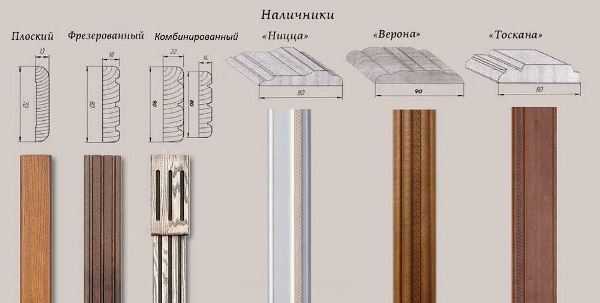
The beauty of the door to a large extent depends on the design of the platbands. They frame the box, covering the joints and irregularities, and finally form the decor of the entrance structure.
Depending on the device, shape, color and material of manufacture, door trims can emphasize or level the aesthetic qualities of the entrance group. The appearance of the door and the opening as a whole depend on the correct choice.
The platband is a carved or figured plank superimposed on the door frame for the purpose of decorative framing. Currently, platbands for entrance and interior doors are made from the following materials:
Platbands for solid wood doors are made not from solid, but from spliced solid wood. It is covered with paint or varnish.
Platbands for plastic doors are highly resistant to moisture and temperature extremes. They are made of PVC or polyurethane. As a rule, they are equipped with cable channels. They don't rot, they don't mold.
Platbands for MDF doors are made of medium-density chipboard or MDF. The cost from is significantly lower than from the array, and the service life is about the same. The only drawback is the reduced moisture resistance.
For finishing, the same laminate and veneer are used as for the entire structure of the same name made of MDF or chipboard.
Ceramic trims are called platbands, made up of ceramic tiles, which are attached to glue. Stone architraves are less common and are used to decorate entrance doors. Both of the latter finishes are used when the adjacent walls are decorated with the appropriate material. This design is often used on the doors to the kitchen or bathroom.

Entrance openings with iron structures are decorated with metal. For interroom they are not used.
Depending on the shape of the cross section, the platbands are:
The last two types can only be cut at an angle of 45 degrees, while rectangular ones can be cut at 90 degrees.
They also differ in installation methods and are:
For external, installed outside the front door, the use of capitals, carvings and other decorative delights is typical. Interior wooden doors are also often decorated with carved products.
According to the internal structure, the strips are divided into:
In the cavities of the latter, you can hide all kinds of cables, which is the reason for their name.
According to the method of fastening, such products are divided into the following types:
Telescopic architraves are wooden or polyurethane. The fastening of such products is characterized by ease of installation / dismantling due to the design. The slats have an L-shaped shelf that fits snugly into the groove on the box. It is a pleasure to work with such, but they require accuracy.
The difficulty is cutting. The shelf does not make it possible to lay the casing evenly, so you have to use a lining. It is made from any wooden block with a thickness equal to the height of the shelf.

To eliminate the appearance of burrs, the bar is cut from the outside. The fit also has its challenges, as it must be perfectly accurate. But neither hats nor other parts of the fasteners will be visible. More often they are cut at a right angle - it's easier to combine the parts. But it does not look very nice, so it is recommended to still connect the parts at an angle of 45 degrees.
At the same time, it is possible to adjust the landing depth, if the width of the walls in the opening requires it. During installation, glue is used for greater bonding strength. If extensions are used, then products with special grooves are selected for telescopic platbands.
The order of installation of decorative strips is as follows:
Specialists cut wood with a circular saw. At home, they use a miter box and a hacksaw. It's quite difficult. First, a horizontal bar is cut. A dot is marked on the lower part on the front side and a cut is made with a guide to the docking part of the box.

Installation is carried out after complete drying of the mounting foam, if a new box was installed. Parts of the frozen foam protruding beyond the plane of the wall are cut off with a clerical knife. They are mounted in such a way as to completely close the box. In the process of fitting, several fittings are performed, excluding the influence of the platbands on the operation of the loops, under which cutouts are also made.
On the video you can see the installation of platbands:
The number of fasteners should be minimal, as the caps spoil the appearance. It is selected specifically in place - depending on the tightness of the fit. To identify voids, they simply tap on it. Masters use an air gun loaded with hairpins.
Usually, doors are installed by specialists from the manufacturer or the store where they were purchased. They also immediately produce and install platbands. But the owners sometimes have to remove them to make repairs or, for example, lay wiring.
Products gradually lose their original beauty, and they have to be changed. Interior structures in general are often purchased "naked". In a word, anyone at least once in their life will face the problem of choice and installation. Material, color and texture are selected for a specific box and canvas.